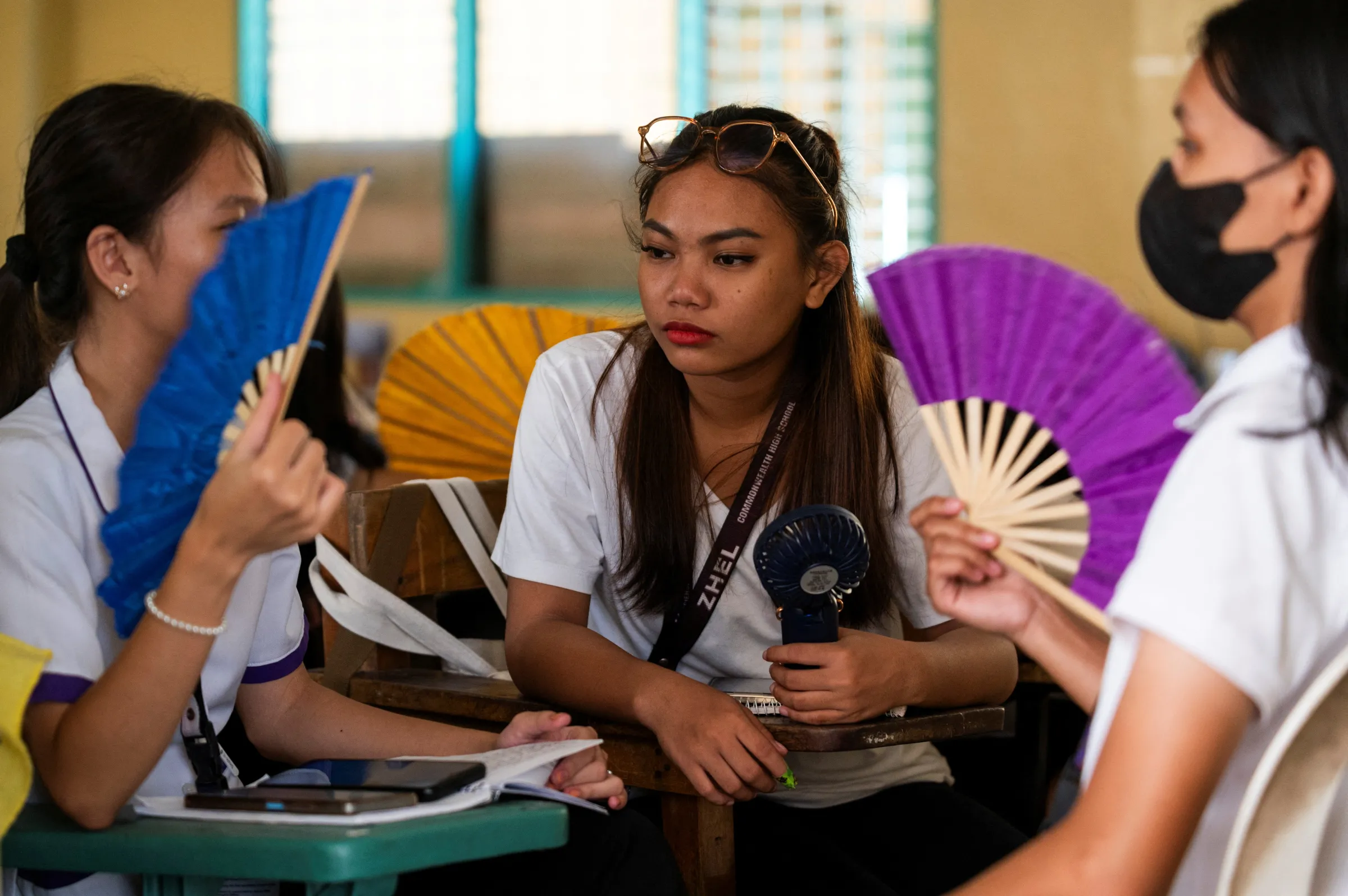Context is powered by the Thomson Reuters Foundation Newsroom.
Our Standards: Thomson Reuters Trust Principles

Grade 12 students use a portable electric fan and hand fans inside a classroom in Quezon City, Metro Manila, Philippines, April 18, 2024. REUTERS/Lisa Marie David
UNICEF warns that heatwaves are pushing millions of children out of school and calls for climate policy to protect classrooms.
NEW DELHI - From scorching hot classrooms to flooded roads, climate change is forcing millions of students out of school, according to new UNICEF data.
Last year, at least 242 million students - or one in seven worldwide - experienced school disruptions due to extreme weather events, according to a June analysis from the United Nations children's agency UNICEF.
Heatwaves were the leading cause of climate-related school disruptions in 2024, affecting more than 171 million students globally, according to UNICEF data. The data from 85 countries shows that children are more exposed to extreme weather than ever before.
Context spoke to Haogen Yao, an education specialist at UNICEF, to understand why education must be part of governments' climate strategies and how low-cost, practical solutions could help keep more children learning as the planet heats up.
Our analysis shows that the scale and frequency of climate-related education disruptions are unprecedented. By the 2050s, eight times more children could be exposed to extreme heat than in the 2000s.
In Madagascar, around 59,000 students were affected by school disruptions in 2024. But by April 2025, in just four months, over 260,000 students had been affected due to a series of cyclones. This reflects the growing intensity of extreme weather and the need for education systems to systematically monitor climate hazards.
Yet most education systems remain ill-equipped to deal with these impacts. Climate-resilient infrastructure is limited, remote learning options are scarce, and education is often missing from climate discussions.
Classrooms become dangerously hot during heatwaves. Children heat up faster than adults and are more vulnerable to heatstroke and dehydration. Learning is nearly impossible in such conditions.
In countries like Bangladesh and the Philippines, heat is cutting school hours short. Other hazards like floods and storms destroy classrooms, school supplies and roads. In Mozambique, Cyclone Chido (in December) damaged more than 1,100 classrooms, affecting over 100,000 students.
When disasters hit, education is often the first service suspended and the last restored. Schools are repurposed as shelters, and families focus on survival. The longer children, especially girls, stay out of school, the less likely they are to return.
Climate and education are deeply linked. Climate shocks directly disrupt schooling, and education is key to resilience.
Heatwaves, floods and storms are pushing children out of classrooms. Yet many countries lack strong education-continuity plans.
Simple solutions, like mobile learning, teacher training and climate-resilient school buildings, are both effective and affordable. Climate education also equips children to stay safe during disasters and supports faster recovery.
Without action, climate impacts will widen education inequalities and leave millions behind.

Teacher works in a classroom after the educational authorities brought forward the end of the school year for students due to high temperatures, in Ciudad Juarez, Mexico July 10, 2023. REUTERS/Jose Luis Gonzalez
Teacher works in a classroom after the educational authorities brought forward the end of the school year for students due to high temperatures, in Ciudad Juarez, Mexico July 10, 2023. REUTERS/Jose Luis Gonzalez
About 74% of affected children are in low-income or fragile settings. These students often lack access to safe schools, the internet or learning materials at home.
South Asia has the largest number of students exposed, but Sub-Saharan Africa faces the highest vulnerability. There, 107 million children were already out of school, and 2024 climate events put 20 million more at risk. In March, a heatwave in South Sudan closed schools nationwide, affecting 2.2 million students.
Niger's worst flooding in 20 years damaged 5,500 classrooms or turned them into shelters. This delayed the school year for 4.6 million children. Heavy rains and flooding along the Niger river in Mali caused a month-long school shutdown, disrupting education for 4.4 million children.
Girls face heightened risks of dropout, early marriage and gender-based violence. Children with disabilities and those in remote areas also face greater barriers to returning.
Even simple upgrades, like painting school roofs white to reduce heat, are low-cost and impactful.
One study found that a one-time investment of less than $20 per child could significantly reduce the learning impacts of climate change. This is one of the best investments to address both the learning crisis and the climate crisis.
Protecting education systems also protects the human capital that underpins long-term growth, resilience and development.
This interview was edited for length.
(Reporting by Bhasker Tripathi; Editing by Ayla Jean Yackley.)
Context is powered by the Thomson Reuters Foundation Newsroom.
Our Standards: Thomson Reuters Trust Principles